Mountain biking, a sport that has dramatically evolved since the inception of the first mass-produced mountain bikes in the 1980s, offers an array of thrilling experiences.
Today’s mountain bikes are intricately designed and purpose-built for different trails, providing enhanced confidence and fun for riders. These technological advancements and innovative designs have made the selection process slightly more complex. Therefore, understanding the basics of mountain bike design is crucial.
Selecting the perfect mountain bike involves thoroughly assessing your riding style, skill level, and the type of trails you plan to conquer. Once you have identified the mountain bike that suits your needs, consider other factors like price and components.
Choosing a mountain bike isn’t just about the bike itself but also the individual parts that make up your bike. Understanding how these components work together can help you make better decisions and get more value for your money.
This guide will break down all these factors, providing insights into making the right choice for a mountain bike.
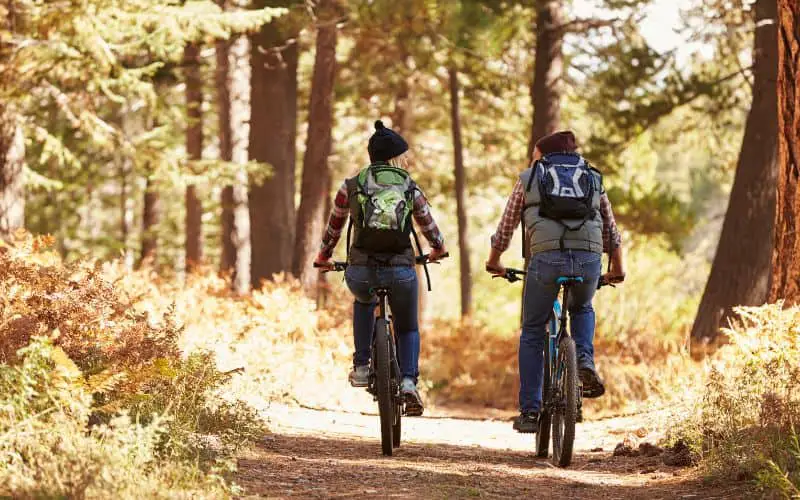
Understanding the Different Types of Mountain Bikes
Mountain bikes come in various categories, each designed to excel in specific tasks.
Let’s quickly run through the different types of mountain bikes, introducing their unique features and helping you identify what to look out for when choosing your mountain bike.
The Versatility of Trail Mountain Bikes
Trail mountain bikes are versatile and suitable for riders who enjoy a bit of everything.
Rather than being designed for a specific type of racing, trail bikes are optimized for all-around fun, providing a balanced performance on climbs, descents, and flat terrains.
These bikes, with shocks on the shorter end of the travel spectrum (120-150mm), are quick-handling, lighter, and pedal more efficiently, making them an excellent choice for most riders.
Some trail bikes offer more travel options (130-150mm), emphasizing steep and challenging descents.
The geometry of these bikes, along with a cushier suspension, allows them to easily tackle steep and challenging terrain.
Whether hardtail (front suspension) or full suspension, trail bikes can handle advanced mountain bike trails. They are perfect for riders who want to explore mostly singletrack routes, balancing performance and comfort.
All-Mountain Bikes for Rugged Terrain
All-mountain bikes are created for those who crave an adrenaline rush on steep descents and challenging trails.
Imagine trail biking but with a more intense twist. These bikes are designed to handle the burliest of terrains, complete with leg-burning climbs and more complex routes.
The design of these bikes is a perfect balance of performance and agility. They offer a smooth ride even on the roughest of terrains, with suspension travel ranging from 140–170mm and a head-tube angle of 65–68 degrees.
These bikes are capable of handling steep descents with ease and are designed to be agile and lightweight enough to pedal uphill, making them a versatile choice for your mountain biking adventure.
Speed with Cross-Country Mountain Bikes
Cross-country mountain bikes are for those who love fast-paced, aerobically challenging races.
They weigh less than trail bikes and have suspension designs that offer less travel, typically around 100mm to 120mm. The firmer pedaling platform of these bikes minimizes bobbing when you pedal, and their steep head-tube angles allow for quick and agile handling.
These bikes are perfect for less technical terrain. They can handle smooth trails with fewer technical challenges but are not as well suited for rougher or steeper trails.
These bikes can either be hardtails, which means they have no suspension in the rear or full suspension.
They are designed for climbing efficiency, thanks to their lightweight design and quick handling. This makes them the perfect choice for riders who value speed and endurance over technical downhill rides.
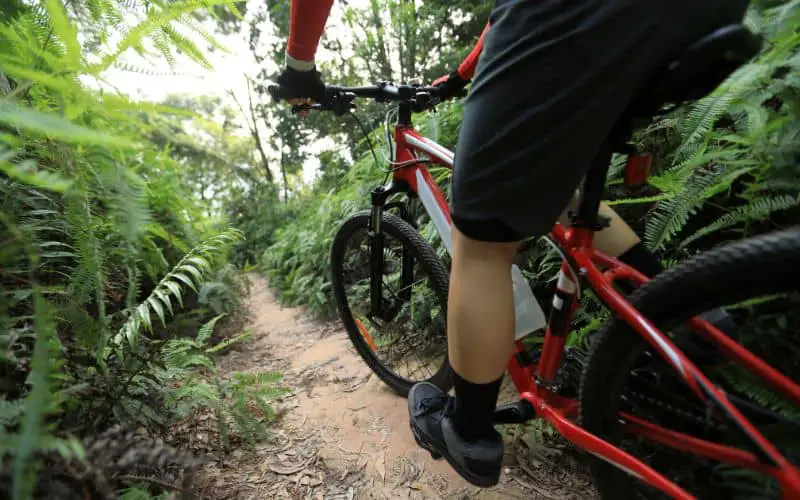
Enduro Mountain Bikes for Competitive Riders
Enduro mountain bikes, also known as all-mountain bikes, are built for the competitive rider.
These bikes are the centerpiece of the “Enduro” race format, where climbing is necessary, but only the downhill sections are timed and scored.
These bikes are designed to handle rough descents while maintaining pedaling efficiency, offering a balance between uphill climbing and pure downhill speed.
The perfect rig for those willing to earn their ride, Enduro mountain bikes are built to handle the most challenging terrains and conditions.
They allow riders to conquer uphill climbs and downhill races, making them popular for competitive riders looking to test their skills and endurance.
The Downhill Thrill with Downhill Mountain Bikes
Downhill mountain bikes are designed for those who live for the thrill of the descent.
With large amounts of travel in their suspension, sturdy frames, and a head-tube angle between 62-64 degrees, these bikes are built to handle drops and jumps confidently.
They offer stability and inspire confidence, making them perfect for tackling jumps, berms, rock gardens, and wooden ramps.
However, these bikes aren’t suited for pedaling more than very short distances. They’re typically used for chairlift or shuttle-assisted riding due to their heavy weight.
But if you’re looking for a bike that can handle the adrenaline-pumping thrill of downhill racing, these bikes are your go-to choice. They embody the downhill rush, designed for those who want to push their limits and conquer the most challenging downhill trails.
Conquering Snow and Sand with Fat Tire Bikes
Fat tire bikes are an excellent choice for those who aim to conquer terrains like snow or sand.
These bikes are designed with wider tires that provide more surface area and floatation, allowing the bike to roll over soft, unstable terrain easily.
One of the critical factors to consider when choosing a fat tire bike is the head-tube angle.
A steeper head-tube angle will allow you to turn faster and climb better. In contrast, a slacker angle will provide more stability when going downhill at high speeds.
Remember, the design does not limit you to the intended riding style. You can always push the boundaries based on your skill and confidence.
The Power Boost of Electric Mountain Bikes (e-MTBs)
Electric mountain bikes or e-MTBs provide a power boost that allows riders to cover more terrain and go farther.
These bikes come with battery-powered motors that assist your pedaling. You can find electric versions of virtually all types of mountain bikes on the market, catering to your preferred riding style.
When choosing an e-MTB, it’s crucial to understand the three classes.
- Class 1 e-bikes are pedal-assist only, topping at 20 mph.
- Class 2 e-bikes have pedal assist and throttle power, allowing the motor to power the bike without pedaling.
- Class 3 e-bikes are pedal-assist only but offer a top speed of 28 mph.
Always check the rules for your local trails before making a purchase.
Essential Factors to Consider When Choosing a Mountain Bike
The perfect mountain bike for you is the one that meets your specific needs and riding style. Let’s take a look at some choices you need to make.
Deciding Between Hardtail and Full-Suspension Bikes
One of the critical decisions you’ll face when choosing a mountain bike is whether to go for a hardtail or a full-suspension bike.
The choice depends mainly on the terrain you plan to ride on and your comfort preferences.
Hardtail bikes have only a front suspension fork, making them ideal for smoother trails.
On the other hand, full-suspension mountain bikes come with a suspension fork and a rear shock, providing better traction and control, especially on rougher trails.
The suspension system on full-suspension bikes is designed to keep the bike’s wheels on the ground, maximizing control for the rider and insulating them from rough terrain. The added benefit of such a design is that it reduces fatigue and ensures a smooth and comfortable ride.
Modern suspension designs have minimized the “pedal bob” that riders used to experience when climbing uphill, making these bikes today suitable for all kinds of terrains.
However, full-suspension bikes may have a slacker geometry, which means you’ll need to be more attentive to steering while climbing.
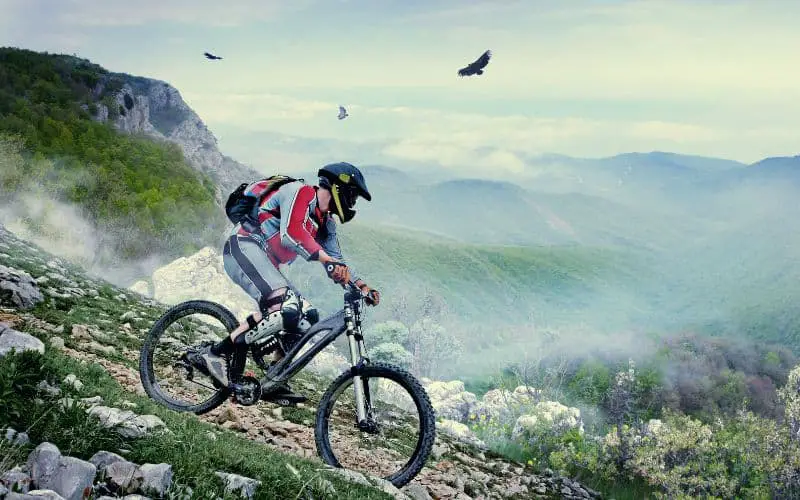
Choosing the Right Wheel Size for Your Mountain Bike
There are a few options when choosing the right wheel size for your mountain bike.
Traditionally, all mountain bikes came with 26-inch wheels. This size is still popular today, particularly for its responsiveness and maneuverability on technical trails. However, as the variety of mountain bikes has expanded, so too have the options for wheel sizes.
Now, when you walk into a bike shop, you’ll likely be asked whether you prefer a 26-inch, 27-inch, or 29-inch wheel size.
Bikes with 27-inch wheels, also known as 650b, offer a more playful feel and are quicker to accelerate. They are often easier to maneuver around tight turns and maintain good momentum.
Meanwhile, bikes with larger 29-inch wheels may feel slower to accelerate, but they roll fast and are ideal for taller riders or those tackling long, straight trails.
How to Select the Best Frame Material for Your Mountain Bike
The material of your mountain bike frame significantly impacts the bike’s weight, durability, ride characteristics, and price.
The most commonly used frame materials are aluminum and carbon fiber.
Carbon fiber is a favorite for high-end mountain bikes due to its strength and low weight, but it has a higher price tag.
On the other hand, aluminum frames are less expensive. However, they are significantly heavier, especially on lower-end models with heavier parts.
The Debate of Aluminum vs. Carbon Frames
The choice between aluminum and carbon frames often comes down to a trade-off between cost and weight.
Carbon frames are lighter and offer excellent performance, but their high cost can be a barrier for some riders. Aluminum frames, while heavier, are more affordable and can still deliver a good riding experience.
It’s important to note that the material is not the only factor affecting a mountain bike’s ride characteristics.
Factors like the frame design and the quality of other components also play a crucial role. Therefore, it’s essential to consider all these aspects together when choosing your mountain bike.
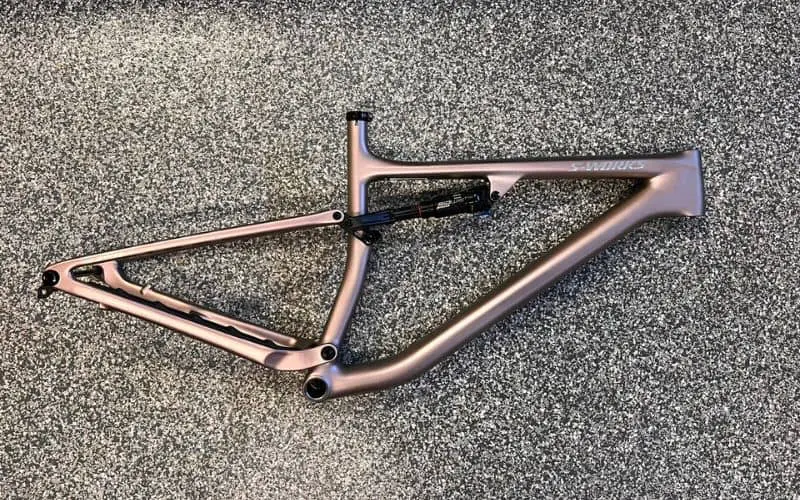
The Impact of Bike Geometry on Your Ride
Your bike’s geometry influences how it handles different terrains and responds to your input.
For example, enduro bikes, with their slack head angles and long wheelbases, are designed for stability and control on steep, rugged downhill trails.
On the other hand, XC bikes feature steeper head angles and shorter wheelbases. They’re built for speed and agility, ideal for racing and climbing.
Electric mountain bikes, for instance, have a different geometry to accommodate the added weight of the motor and battery without compromising stability and maneuverability.
Considering the geometry is not only crucial for trail or competitive mountain biking but also when you’re switching from road bikes to mountain bikes.
Delving into Mountain Bike Features and Accessories
As with everything in cycling, you must have the right features and accessories on your bike.
These elements enhance performance, safety, and comfort, turning an ordinary ride into an unforgettable adventure.
Understanding Mountain Bike Gearing
A mountain bike’s gearing refers to the combination of chainrings at the front (near the pedals) and the set of sprockets at the rear wheel, called the cassette.
The interaction between these two determines how easy or hard it is to pedal, especially when climbing steep trails or racing down a descent.
Gearing allows riders to:
- Climb efficiently: A lower gear (small chainring at the front and larger sprocket at the rear) makes pedaling easier, which helps in climbing steep terrains.
- Ride faster on flat or downhill: A higher gear (large chainring at the front and smaller sprocket at the rear) makes pedaling harder but allows for faster speeds on flat or downhill sections.
- Save energy: Using the right gear for the terrain can significantly reduce fatigue, allowing you to ride longer distances.
Deciding on the correct gearset depends on your riding style, the terrain you often ride on, and your physical ability:
- Type of Terrain: You’ll benefit from a wide range of gears if you ride on varied landscapes with many climbs. You may not need as many gear options if your trails are flat.
- Riding Style: If you love speeding downhill, you might want higher gears. A range of lower gears can benefit technical climbs and trails more.
- Physical Ability: If you’re new to mountain biking or don’t have a lot of leg strength yet, having a broader range of lower gears can make your rides more enjoyable until you build up more strength and endurance.
- Weight Considerations: More gears might mean more weight. Some riders prefer a simpler, lighter setup, sacrificing gear range for reduced weight.
- Single vs. Multiple Chainrings: Modern mountain bikes often have 1 chainring in the front (1x systems, pronounced “one-by”) to simplify shifting and reduce weight. Others might have 2 or even 3 chainrings. A 1x system can offer a broad range of gears, but a 2x or 3x might offer an even broader range or closer spacing between gears.
Air Vs. Coil Spring Suspension: What’s the Difference?
The suspension system in your mountain bike significantly absorbs shock from rough terrains and provides a smoother ride.
There are mainly two types of suspension systems used in mountain bikes: air and coil spring.
Hardtail mountain bikes, for example, can come with either an air fork or a coil fork.
Air forks utilize a combination of pressurized air and suspension fluid to adjust to varying terrains and impacts, contributing to improved bike handling and reduced energy transfer to the rider’s body.
On the other hand, coil forks use a metal coil spring to provide resistance. Although they are more durable and require less maintenance, they are not as good as air forks at absorbing impacts. This can result in a less comfortable ride, especially on uneven trails.
Therefore, investing in a bike with an air fork might be a better choice if you want a smoother and less exhausting ride!
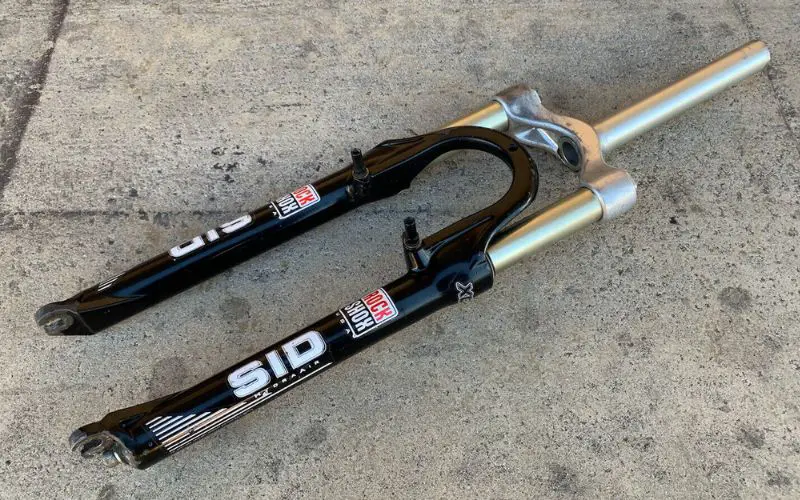
Hydraulic vs Mechanical Brakes: Which is Better?
Most modern higher-end mountain bikes have adopted hydraulic brakes due to their advantages in performance and better control over braking.
However, some entry-level bikes and certain niche markets still use mechanical brakes because of their cost and ease of maintenance.
So, what are the key differences?
Hydraulic brakes use fluid inside a sealed system. When you squeeze the brake handle, this fluid moves and makes the brake pads press onto the rotor.
These brakes give consistent and strong stopping power and adjust on their own as they wear out. They allow riders to have better control over braking and need less hand strength.
On the flip side, they might be a bit harder to maintain and there’s a small chance of fluid leaks.
Mechanical brakes work with a physical cable. Pulling the brake handle tightens this cable, causing the brake pads to press against the rotor.
These brakes are simpler, often cheaper, and easier for most people to fix. However, they might need more hand force to stop the bike, and as time goes by, the cables can stretch which affects how well they work.
As the brake pads wear down, you’ll need to adjust them manually.
The Benefits of Tubeless Tires
Tubeless tires are increasingly becoming the preferred choice among mountain bikers.
They work without an inner tube and use a sealant solution that can immediately patch small punctures. This feature considerably reduces the possibility of a pinch flat.
Moreover, tubeless tires allow riders to run lower tire pressures, which means better traction and a smoother ride.
Most bikes are sold with tubes, but if you look closely, you’ll find bikes whose wheels and tires have a label or sticker stating “TLR” (tubeless-ready) or otherwise indicating that they can roll without tubes.
If the bike you’re considering doesn’t have tubeless-ready wheels, be sure you understand what you’re committing to. Swapping out wheels later can be quite an expensive task.
Why You Should Consider a Dropper Post
When riding a mountain bike over varied terrain, moving your body back and forth over your bike is crucial.
Most mid to high-end bike models today have dropper posts to make this easier. These are seat posts whose height you can adjust with the push of a remote button on the handlebar, allowing for more mobility during your ride.
Dropper posts have become so commonplace that most experienced riders today would struggle to ride without one.
If the bike you are considering doesn’t have a dropper post, don’t worry. It’s one of the easier parts to upgrade down the line.
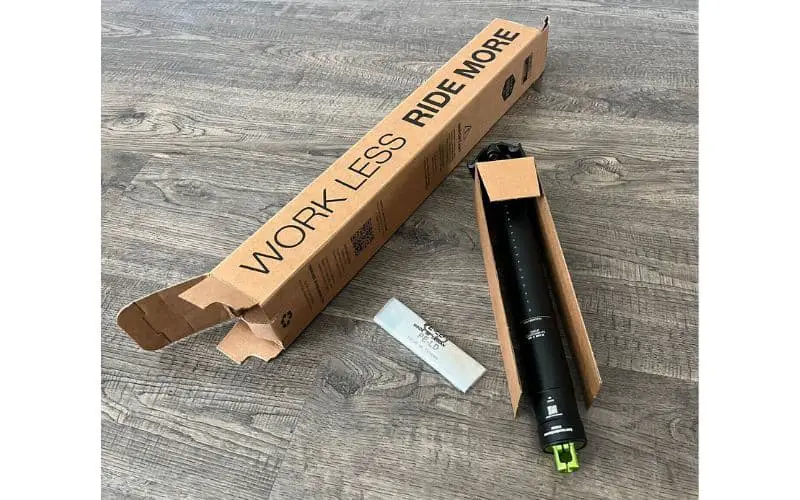
The Importance of the Right Mountain Bike Size
After you’ve thought about your riding style and the type of mountain bike, you should consider the size of your bike.
In this section, we’ll help you understand how to find a bike that fits perfectly.
How to Determine Your Mountain Bike Size
Here’s a simple guide on how to determine the mountain bike size you need:
- Measure Your Height: Stand straight against a wall and measure your height from head to toe.
- Check Size Chart: Look up the mountain bike size chart for the brand you’re interested in. These charts typically match your height to a recommended bike frame size.
- Standover Height: The space between you and the bike’s top tube when you stand over it should be a couple of inches. This ensures you won’t hurt yourself if you need to stop quickly.
- Test Ride: Visit a local bike shop and test ride the recommended size. Your arms and legs shouldn’t feel too stretched out or too cramped.
- Ask for Help: If in doubt, talk to the staff at the bike shop. They can advise sizing and adjust parts like the saddle or handlebars to fit you better.
- Final Check: When you sit on the bike, your knee should slightly bend when the pedal is at its lowest point. This means the saddle height is right for you.
Check out this post for more information on picking the right bike size.
Pros and Cons of Buying Direct
Buying a mountain bike directly from the manufacturer can offer several advantages.
The biggest benefit is often the cost. Direct purchase usually allows you to bypass the middleman, resulting in significant savings.
Additionally, buying directly ensures you get the latest model with the most recent technological advancements. Some bike shops have continued selling older models for quite some years.
However, there are also some downsides to buying directly.
The biggest issue is that you can only physically test the bike after purchasing it! This can make finding the perfect bike that fits your body and riding style more challenging.
Furthermore, the after-sales service can sometimes be less satisfactory than buying from a local bike shop, where you can build a relationship with the staff.
Frequently Asked Questions
Does the weight of a mountain bike matter?
Yes, weight impacts performance. Lighter bikes, often seen in cross-country bikes, allow for faster acceleration and uphill performance.
However, a slightly heavier bike might offer more stability, especially for downhill and technical terrains.
How important is suspension in mountain biking?
Suspension absorbs impacts from obstacles and improves traction, especially in rough terrains.
Cross-country bikes often come with front suspension (hardtail), while trail and downhill bikes typically feature full suspension.
Your choice should align with the type of trail riding you plan to do.
Can I use my mountain bike for other types of riding?
While mountain bikes are designed for off-road terrains, they can be used on roads and paths.
However, they might be less efficient than road bikes due to their heavier build and knobby tires. Consider versatile tires or a gravel or hybrid bike if you ride mixed terrains.
What’s the difference between a road bike and a mountain bike?
Mountain bikes are designed for rugged off-road terrains, featuring knobby tires, a robust frame, and often suspension systems to handle shocks.
On the other hand, road bikes are optimized for speed on smooth surfaces. They have lightweight frames, thin tires, and a more aerodynamic design to maximize efficiency on paved roads.
Are gravel bikes a good compromise between road and mountain bikes?
Gravel bikes combine elements of both road and mountain bikes. They’re designed for mixed terrains, from paved roads to rough gravel paths. They have drop bars like road bikes but wider tires similar to mountain bikes (though less knobby).
They’re versatile, making them a good choice for riders who want one bike for various conditions, but they might not excel in extreme terrains like a dedicated mountain bike would.
Wrapping Up Your Mountain Bike Selection Guide
There you have it! Mountain biking is a diverse sport, with different styles suited to various terrain and rider preferences.
Each mountain biking style has unique characteristics and requires a specific type of bike. Understanding these differences is vital to finding the right style of bike for you.
Hopefully, you found this article helpful, and it provides a gateway to the world of mountain biking!
To help you get started here are a few roundups to get you started:

